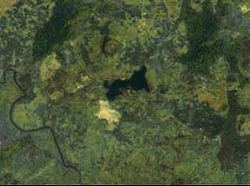Type Meromictic | Basin countries Cameroon | |
 | ||
Lake monoun
Lake Monoun is a lake in West Province, Cameroon, that lies in the Oku Volcanic Field 5.58°N 10.59°E / 5.58; 10.59. On August 15, 1984, the lake exploded in a limnic eruption, which resulted in the release of a large amount of carbon dioxide that killed 37 people. At first, the cause of the deaths was a mystery, and causes such as terrorism were suspected. Further investigation and a similar event two years later at Lake Nyos led to the currently accepted explanation.
Contents
Map of Lake Monoun, Cameroon
Disaster
Several people reported hearing a loud noise on August 15, 1984 around 22:30. A gas cloud reportedly emanated from a crater in the eastern part of the lake. The resulting deaths of residents in a low-lying area are believed to have occurred between 03:00 and dawn. The victims were said to have skin burns, which reports later clarified as "skin damage" such as discoloration. Survivors reported that the whitish, smoke-like cloud smelled bitter and acidic. Vegetation was flattened around the eastern part of the lake, probably by a tsunami.
Although Lake Monoun is near the center of a volcanic field that includes at least 34 recent craters, the subsequent investigation found that the event was not caused by an eruption or sudden ejection of volcanic gas from the lake. Rather, emission of carbon dioxide in a limnic eruption is thought to be to blame. The cloud's smell and skin damage to victims were not fully explained. Some theories attribute the skin problems to a combination of preexisting conditions and routine postmortem effects like livor mortis, although there is no clear consensus.
Among the victims were some of the riders in a truck carrying twelve people. The truck's engine stopped working, and the people inside the truck got out and were killed. Two people sitting on top of the truck survived, because their elevated position allowed them to breathe - carbon dioxide is heavier than air (oxygen and nitrogen) which causes it to stay close to the ground.
Two years later, on 21 August 1986, a similar and even more deadly event occurred at Lake Nyos, about 100 km (62 mi) NNW, killing about 1746 people and more than 3,000 livestock. Along with Lake Nyos and Lake Kivu, Lake Monoun is one of only three lakes in the world known to have high concentrations of gas dissolved deep below the surface, which can result in a limnic eruption.
Degassing
In 2003, a venting pipe was inserted into the lake, in an effort to prevent the disaster from recurring. Initially a pump was needed to pull water from the bottom, but as carbon dioxide began to come out of solution it created buoyancy in the water in the pipes, allowing the pump to be turned off.
However, a study in September 2005 by George Kling and other researchers at the University of Michigan found that gas was not being removed from the lake quickly enough to ensure that the disaster never happens again. Kling recommended the lowering of the existing pipe and the addition of a new one in order to release more carbon dioxide.
